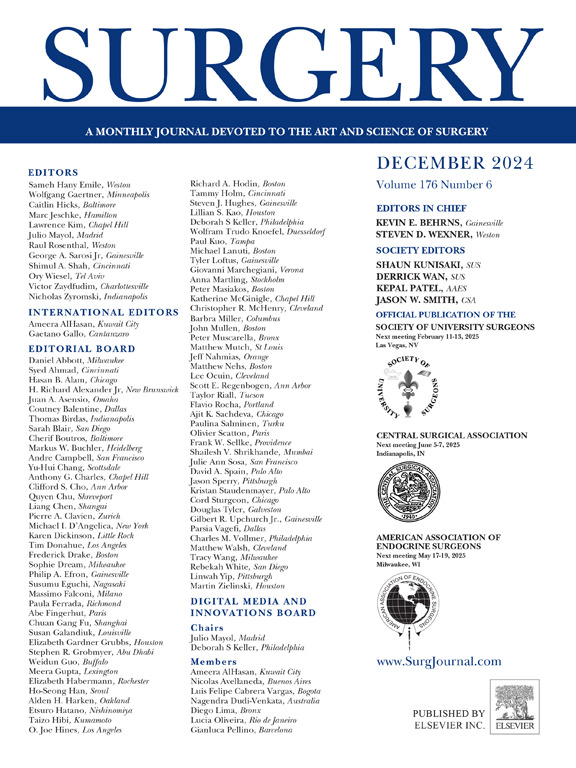大手术后残留异物:趋势、风险因素及相关结果
IF 3.2
2区 医学
Q1 SURGERY
引用次数: 0
摘要
背景:异物潴留是外科手术中罕见的并发症,与不良事件和医疗费用增加有关。虽然以前的工作报告了残留异物的发生率,但评估当代趋势以及风险因素和相关结果的最新国家数据仍然有限。方法采用2018-2022年全国住院患者样本,确定所有涉及心脏、胃肠、泌尿生殖系统、神经外科、骨科、胸外科和血管手术的住院病例。根据是否有异物残留对患者进行分类。我们建立了多变量回归模型来评估残留异物与危险因素和相关结果的关系。结果在26333269例外科住院患者中,4570例(0.017%)合并诊断为异物残留。2018年至2022年,异物残留比例从1/ 5400例下降到1/ 6000例(P <.001)。相对于心脏手术,胃肠道(校正优势比2.26;95%可信区间,1.63-3.13),胸部(校正优势比;3.22, 95%可信区间,2.05-5.10),血管(校正优势比,2.78;95%可信区间,1.89-4.10)和多腔(校正优势比,2.10;95%可信区间,1.50-2.93)手术与较大的残留异物发生率相关。此外,在小床位的医院接受治疗与减少残留异物事件的可能性有关(调整优势比,0.79;95%可信区间为0.65-0.95),而在美国西部医院接受治疗与增加的风险相关(调整后的风险比为1.29;95%置信区间为1.05-1.59)。异物残留也与并发症风险增加、住院时间延长和住院费用增加有关。结论尽管异物潴留率有所下降,但需要进一步努力制定标准化的安全方案和技术解决方案,以实现零发生率预防。本文章由计算机程序翻译,如有差异,请以英文原文为准。

Retained foreign bodies after major operations: Trends, risk factors, and associated outcomes
Background
Retained foreign bodies are rare complications of surgical practice that are associated with adverse events and increased health care costs. While previous work has reported on the incidence of retained foreign bodies, updated national data evaluating contemporary trends as well as risk factors and associated outcomes remain limited.
Methods
The 2018–2022 National Inpatient Sample was used to identify all hospitalizations entailing major cardiac, gastrointestinal, genitourinary, neurosurgical, orthopedic, thoracic, and vascular operations. Patients were categorized based on the presence of a retained foreign body. Multivariable regression models were developed to evaluate the association of retained foreign bodies with risk factors and outcomes of interest.
Results
Of an estimated 26,333,269 surgical hospitalizations, 4,570 (0.017%) carried a concomitant diagnosis for a retained foreign body. The proportion of cases with a retained foreign body decreased from 1/5,400 to 1/6,000 cases from 2018 to 2022 (P <.001). Relative to cardiac operations, gastrointestinal (adjusted odds ratio, 2.26; 95% confidence interval, 1.63–3.13), thoracic (adjusted odds ratio; 3.22, 95% confidence interval, 2.05–5.10), vascular (adjusted odds ratio, 2.78; 95% confidence interval, 1.89–4.10), and multicavity (adjusted odds ratio, 2.10; 95% confidence interval, 1.50–2.93) operations were associated with greater odds of retained foreign body occurrence. Moreover, treatment at hospitals with small-bed size was linked to reduced likelihood of retained foreign body event (adjusted odds ratio, 0.79; 95% confidence interval, 0.65–0.95), whereas care at hospitals in the Western United States was associated with increased odds (adjusted odds ratio, 1.29; 95% confidence interval, 1.05–1.59). Retained foreign body occurrence was also associated with a greater risk of complications, prolonged hospital stay, and increased hospitalization costs.
Conclusion
Despite a declining incidence of retained foreign bodies, further efforts focused on standardized safety protocols and technological solutions are needed to achieve zero-incidence prevention.
求助全文
通过发布文献求助,成功后即可免费获取论文全文。
去求助
来源期刊

Surgery
医学-外科
CiteScore
5.40
自引率
5.30%
发文量
687
审稿时长
64 days
期刊介绍:
For 66 years, Surgery has published practical, authoritative information about procedures, clinical advances, and major trends shaping general surgery. Each issue features original scientific contributions and clinical reports. Peer-reviewed articles cover topics in oncology, trauma, gastrointestinal, vascular, and transplantation surgery. The journal also publishes papers from the meetings of its sponsoring societies, the Society of University Surgeons, the Central Surgical Association, and the American Association of Endocrine Surgeons.
 求助内容:
求助内容: 应助结果提醒方式:
应助结果提醒方式:


